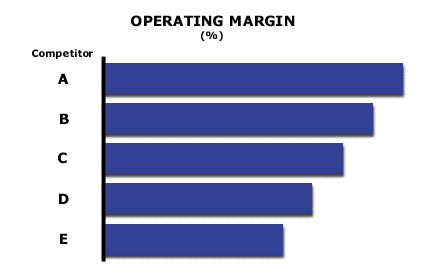Analysis 54: Operating Margin
EXHIBITS:

| HOW TO INTERPRET THE ANALYSIS: The exhibit is shown here without numbers. However, Competitor A would have the lowest operating cost in the industry because it has the highest operating margin (eg. EBIT/Sales ratio). The operating costs of the Company include primarily its costs for purchases and people. When the operating costs are subtracted from sales, the result is an operating margin in dollars. When that operating margin in dollars is divided by sales, the result is a percentage number, the operating margin or Return on Sales (ROS). The higher the operating profit margin as a percentage of sales, the lower is the company's operating costs, the costs of people and purchases.
PURPOSE: This analysis evaluates the operating cost position of the Company compared to its competition. The competitor with the highest pre-tax return on sales has the lowest operating cost. The Company uses this analysis to evaluate its past performance and to set future performance targets to meet its operating margin (ROS) goals. APPROACH: This analysis divides the EBIT of each company by its total sales. If the Company does the analysis using business line data, this analysis is the calculation of business segment operating profits divided by sales. Operating costs include primarily the costs of people plus outside purchases. Depreciation (a form of Capital cost) is included in operating costs but capital carrying costs, such as interest on debt, are excluded from this calculation. In most companies, the costs of people and purchases is many times the cost of depreciation. As a result, the competitor in this analysis who has the highest pretax return on sales has the lowest costs of people plus purchases in the industry. The Company would then use the low cost (high return) competitor to benchmark its operating cost performance. Return to Diagnose Costs: Measuring Current Shortfalls in Financial Performance |
|
Recommended Reading |
| For a greater overall perspective on this subject, we recommend the following related items:
Analyses: Videos: Symptoms and Implications: Symptoms developing in the market that would suggest the need for this analysis.
Perspectives: Conclusions we have reached as a result of our long-term study and observations.
|
